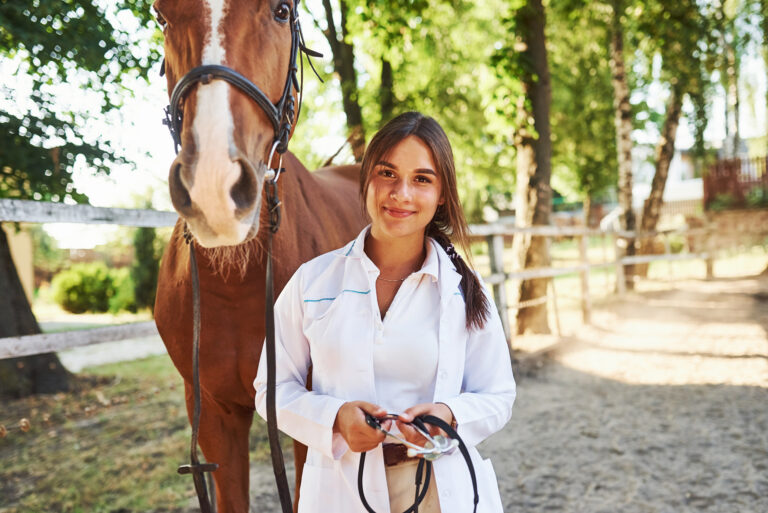
Equine botulism makes the headlines nearly every year when horses die from ingesting this potent toxin. In episode 105 of the Disease Du Jour podcast, we learn from Amy Johnson, DVM, DACVIM (Large Animal and Neurology). She is the Marilyn M. Simpson Associate Professor of Equine Medicine, University of Pennsylvania School of Veterinary Medicine—New Bolton Center, and the Section Chief, Internal Medicine & Ophthalmology, University of Pennsylvania School of Veterinary Medicine.
What Is Equine Botulism?
Botulism is a disease of horses and many other species, including people, said Johnson. “Horses do seem to be uniquely susceptible to the effects of the toxin,” said Johnson. “It requires a smaller amount on a weight basis to make horses show clinical signs than virtually every other species.”
It is a disease that manifests as very profound muscle weakness throughout the body, particularly in the muscles used to stand and to swallow, she said. “It’s actually an intoxication,” said Johnson. “It is caused by a toxin that is produced by the bacterium Clostridium botulinum.”
Botulinum toxins are one of the most lethal substances known. In humans, the median lethal inhaled dose has been estimated at 2 nanograms of botulinum toxin per kilogram of bodyweight, which is approximately 3 times greater than in foodborne cases, according to the World Health Organization. (Remember that one nanogram is one billionth of a gram.)
“Botulinum neurotoxin poses a major bioweapon threat because of its extreme potency and lethality; its ease of production, transport, and misuse; and the need for prolonged intensive care among affected persons. A single gram of crystalline toxin, evenly dispersed and inhaled, can kill more than one million people,” noted the article Botulinum toxin: Bioweapon & magic drug.
There are three main types of botulism in horses. The most common—and the one we talk about in this podcast—is when a horse ingests the botulism toxin in feedstuffs. The other ways horses acquire the toxin are through wounds and “infant” botulism, which in horses is called shaker foal syndrome. That is when Clostridium botulinum is found growing in the GI tract of a young foal and produces toxins there.
Botulism in Horses
This bacterium grows in low oxygen environments that are moist and alkaline or basic in the environment, according to Johnson. This can be places such as a big round or square bale of hay, especially if it wasn’t cured properly before baling.
“Botulism is hard to diagnose in the early stages,” said Johnson. “It can look like colic or choke.”
She said veterinarians should look for horses having trouble manipulating food from the front to the back of the mouth. They also might see feed coming from the nostrils.
Other clinical signs can be muscle tremors and weight shifting. “They are trying to fight gravity,” explained Johnson.
As horses get weaker they lie down. They might get up again and walk around, then lie down again. When forced to exercise, they can sweat.
Johnson said veterinarians should watch a horse lie down and see if it is still painful when it is down. She said when a horse with colic lies down, it is still painful. When a horse with botulism lies down, it seems calmer.
Equine Botulism and Vaccination
Johnson said in the United States, you can find botulism types A, B and C. “A and B are frequent soil contaminants, with B predominately found East of the Mississippi river,” she noted. “A is primarily west of the continental divide.”
There is a vaccine for the type B botulism in horses. However, Johnson said the vaccine isn’t cross-protective to other types of equine botulism.
More in the Podcast
Listen to the complete podcast to learn more about clinical signs and diagnosis of equine botulism. Johnson also talks about treatment and how to help owners avoid exposure to botulism.
About Dr. Amy Johnson
Amy Johnson, DVM, DACVIM (Large Animal and Neurology) is one of only five veterinarians in the world to be board-certified in both large animal internal medicine and neurology, and one of only two veterinarians practicing large animal neurology in the United States. She has been a clinician at New Bolton Center since 2007 and was appointed to the faculty as assistant professor of large animal internal medicine and neurology in 2011. Johnson is the Marilyn M. Simpson Associate Professor of Equine Medicine, University of Pennsylvania School of Veterinary Medicine at New Bolton Center, and she is the Section Chief, Internal Medicine & Ophthalmology, University of Pennsylvania School of Veterinary Medicine.
Dr. Johnson received her veterinary degree from Cornell University, where she also completed a residency and became board-certified in large animal internal medicine in 2007. After joining New Bolton Center as a lecturer in 2007, she completed a second residency in neurology at the University of Pennsylvania, becoming board-certified in neurology in 2011.
Her research interests include large animal neurology, equine neurology, bovine neurology, camelid neurology, small ruminant neurology, porcine neurology, Clostridium botulinum type B and botulism, Sarcocystis neurona, equine protozoal myeloencephalitis, Borrelia burgdorferi and Lyme neuroborreliosis.









